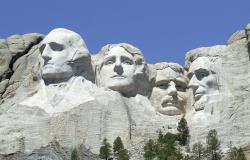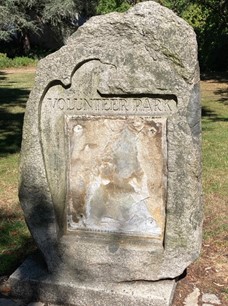Monumental Debate

Scott Montgomery argues against an absolutist position in the debate over monument removal.
This brief essay is a response to a colleague, whom I respect for being outspoken on difficult issues. The particular issue in this case involves an opinion he wrote about monuments and the need to erase or destroy them in circumstances where they serve to elevate leaders of imperialism and colonization, the slave trade, the Confederacy, and other proponents of modern racism.
Most readers will know this has been a topic of fevered controversy for several years, particularly since the May 2020 killing of George Floyd by police in the U.S. city of Minneapolis. Following this murder, many monuments have indeed been taken down, officially and otherwise, as well as defaced, smashed, and exiled to museums. In the U.S., this movement actually began in 2015, after a young white supremacist shot dead nine black people at a Church in Charleston, South Carolina. Public outrage led to removal and banning of the Confederate flag from state property, major events (NASCAR races), military bases, and more in much of the American South.
My university colleague focused his excoriating words on a plaque in one of Seattle’s major parks. The words at issue commemorated “Spanish-American War veterans who liberated the oppressed peoples of Cuba, Puerto Rico, and the Philippine Islands.” As a historian of SE Asia, my colleague rightly noted that this counts as a grotesque falsification. The 1898-1902 war for the Philippines was actually an exchange of oppressors. After defeating and driving out the Spanish fleet, the U.S. proceeded to invade the country, causing the death of between 200,000 and 300,000 civilians. American annexation remained in effect until 1946.
 My colleague’s complaint was made in the name of historical fact, against the whitewash of atrocity. His letter had its desired impact: park authorities ordered the plaque removed. History, however, is more than facts and lies. Debate, meantime, is larger than disagreement. So, I can agree with the impulse of my colleague while also suggesting a somewhat different corrective.
My colleague’s complaint was made in the name of historical fact, against the whitewash of atrocity. His letter had its desired impact: park authorities ordered the plaque removed. History, however, is more than facts and lies. Debate, meantime, is larger than disagreement. So, I can agree with the impulse of my colleague while also suggesting a somewhat different corrective.
I add a few facts that he felt were not needed. One is that Kipling wrote “The White Man’s Burden” (1899), with its message ‘you will do great things for civilization but be unloved for it,’ as specific encouragement and warning to the U.S. in its war against Spain. At the time, this was like wisdom imparted by a lofty imperium to an ambitious novice.
The role of the press, the Hearst-Pulitzer clash, with its flood of ureic journalism, did not so much cause the war as channel the flow of desire for it to a thirsty public. Henry Adams noted that “the Philippines [w]as a question of balance of power in the East.” With Britain’s urging, the U.S. emerged as a new world presence, upholding Western supremacy.
The plaque in Seattle’s park thus qualifies as a document of the exceptionalist sentiment of the time, the fictions America told itself about doing good and maintaining needed political and racial power. How and why did Americans come to believe they were heroes in this conflict? What was behind the daunt that becoming an imperial state, after having devastated their own native peoples, was part of a paladin national destiny?
The largest monument in America is not in Washington D.C. It sits near the “battlefield” of Wounded Knee, where, in 1890, the U.S. army massacred hundreds of Lakota Sioux, half of them women and children. A generation earlier, in 1868, the federal government signed a treaty with the Sioux nation, granting it ownership in perpetuity over the Black Hills area of southeastern South Dakota. It proved a perpetuity of eight years. In 1876, gold was discovered and a rush for stakes and settlement began. Land that was given back to the people who had lived on it for centuries was taken away a second time.
Mt. Rushmore National Memorial occupies a massive granite cliff. It consists of four presidential heads—George Washington, Thomas Jefferson, Abraham Lincoln, and Theodore Roosevelt. Each is 18-20 meters (~60 ft) tall, scaled for a figure 142 meters (469 ft) in height. Choice of presidents is meant to symbolize the founding, expansion (via the Louisiana Purchase), preservation, and culmination of the nation. While the sculptor, Gutzon Borglum, was thinking of the Panama Canal to justify Roosevelt’s inclusion, there is more than a small chance he also had Cuba and the Rough Riders, as well as the Philippines, in mind.
Begun in 1927, the project struggled to gain funding in the Depression. After a decade, it was abandoned by being declared complete. In fact, the great bas-relief heads are only a minor part of a grander plan that would have seen them extend head to waist. There was also to be a “Hall of Records” and a large entablature of heroic events. Eleanor Roosevelt proposed that the head of Susan B. Anthony be added, and Congress took up the idea, only to see it fail.
Before the cliffs of Rushmore, Borglum worked the steep gray granite of Stone Mountain, Georgia. Contracted by the United Daughters of the Confederacy in 1915, he planned a great bas-relief of Robert E. Lee, Jefferson Davis, and Stonewall Jackson, all on horseback, followed by Confederate troops. Also planned: an altar to the Ku Klux Klan, who helped provide funding. Borglum soon abandoned the project after squabbles over design and money, with the monument completed by another sculptor, Henry Augustus Lukeman. It remains on the mountain side, like a huge postage stamp. Calls for its removal have been made.
In their very scale, Rushmore and Stone Mountain show that a monument’s true effort is sometimes to protect myth from history. History will always involve questioning and changing interpretations, a chipping away at earlier, more “innocent” meanings. It is no accident, then, that memorials are made out of the same material (granite, marble, etc.) as tombs.
Another way of saying this. We usually say that monuments exist to commemorate, enshrine, remind us of a past event or person. Public memory is most often the object, though historians would quickly add that “national myth-making” forms the subject. In many cases, however, myths live longer than truth. Monuments, that is, are built less to preserve history than to freeze, petrify its meaning. Such is what makes them historical documents themselves.
The vast majority of Confederate monuments were built between the 1890 and 1950, to help install the “Lost Cause” myth of the Civil War. This claimed that the vanished culture of the prewar (antebellum) South was noble, chivalrous, based on honor and gentility, not centered on slavery, which in any case was gentle and caring, thus worth fighting to preserve. These monuments coincided directly with the era of Jim Crow segregation, rise of the Ku Klux Clan terrorism, and over 4,000 lynchings of black people. Though 11 states formed the Confederacy, monuments heroifying Southern generals and politicians were erected in 31, much aided by the Daughters of the Confederacy, Borglum’s patrons at Stone Mountain. Such memorials therefore qualify as documents, not of memory but intended forgetting and erasure, anti-history. Somewhere around 850 monuments were put up. About 140 have been removed.
We may regret, admire, or despise what a memorial says, but this does not change the truth of what it expresses about its own time. This is both a reason to remove many of them, but also to preserve certain of them after applying a new context.
On a strictly factual basis, that is, the plaque in Volunteer Park inscribed both a lie and a truth. Its words represent an effort to transform a war of naked oppression into a courageous struggle for liberation (as my colleague notes, the Filipinos were the one’s fighting for their freedom). How does a nation that poses itself as the land of liberty come to think and act this way? To merely say that these were the sort of lies colonizers told themselves for the sake of profit and power is unhelpful. The question, after all, bears not a little on the current war in Ukraine.
Teaching about the Spanish-American War provides a good opportunity for presenting such a plaque (and other examples) as kindling to discussion and reflection. But why confine this to the academic classroom? Why cleanse a nation of public evidence for past evils? We have museums, yes, but they also serve a sanitizing function, suggesting the past can be mummified and easily labeled. A monument left standing in public is a kind of confession. The logic for removal, then, taken to its endpoint, would burn all such documents, thereby purifying the nation to look far better than it has been.
The plaque mentioned here is likely to be offensive to people of Filipino descent who stop to read it. Today, like the 1890s, is an ugly time in the U.S., including anti-Asian bigotry and violence. As it happened, the local community, after an open public meeting, petitioned Seattle Parks & Recreation to have the plaque removed. That the process was inspired by a historian originally from Germany, a country that has worked to force itself into dealing with its horrific past, may be meaningful. Very few other nations—not Japan, Italy, Belgium, Russia, France, Spain, Portugal, the UK, nor the U.S.—have done as much to acknowledge the brutalities for which they are responsible.
Nonetheless, I would argue against an absolutist position in the debate over monument removal. This applies, for example, to the wish for eliminating all memorials to the founding fathers who were slave owners—Washington, Jefferson, Madison, Franklin, Hancock, Henry, Dickinson, et al. These men were essential actors in establishing the liberal values that they failed to live up to. They deserve public visibility, to be admired, accused, questioned, and debated, their final significance left in argument.
The lies of memorials can be defeated by context. Adding history to anti-history doesn’t result in a vacuum but in restorative substance. The question is often how to do this—in the case of the plaque mentioned here, one idea would be an exhibit in the park about its own development, the memorials chosen for it, the questions and problems they raise. Unchanged, after all, is the very name of the place—Volunteer Park—linked to the same historical events.
Should monuments that applaud the Confederacy be removed? Absolutely, but not all of them. Some, perhaps even the most blatant, should be left standing with added comment. The greater number were installed during the worst era of segregation, 1890s to 1950s, therefore not to honor fallen soldiers but to speak about the persistence of racism, white supremacy, and the U.S. version of apartheid, with its “Lost Cause” folklore.
Meanwhile, the granite stone near the entrance to Volunteer Park sits with the rectangular plaque stripped away, leaving the outline of an eagle and a scab-like portion. Perhaps it will be eventually be replaced with something more neutral or anodyne. Yet left as it is, it would be no less a document revealing of a history that is far from over. My colleague, I think, would agree.
Scott L. Montgomery is an author, geoscientist, and affiliate faculty member in the Jackson School of International Studies, University of Washington, Seattle. He has 25 years' experience in the energy industry, where he worked on projects in many parts of the world. His many technical publications include papers, monographs, articles, and textbooks, mainly focused on cutting edge hydrocarbon plays, technologies, related impacts and issues.
Photo by Pixabay
Photo: Author's own


